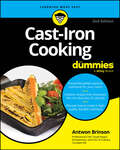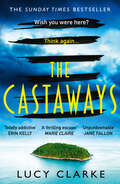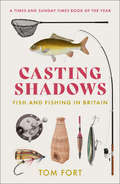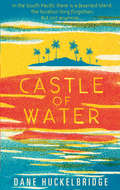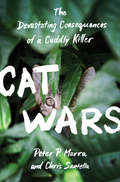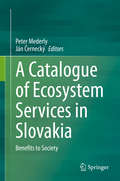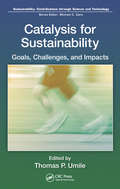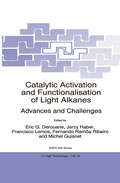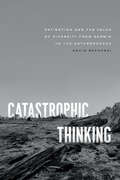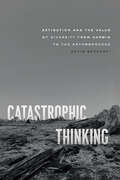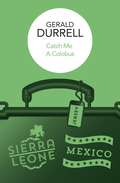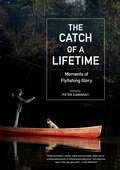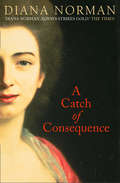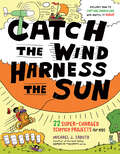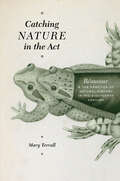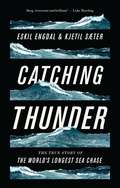- Table View
- List View
Cast-Iron Cooking For Dummies
by Antwon BrinsonBecome a cast-iron chef, thanks to this friendly Dummies guide Cast-Iron Cooking For Dummies will teach you everything you need to know to start using the classic cookware that chefs have loved for thousands of years. You’ll learn how to pick the right cast iron tools for your needs, maintain your cookware, and cook foods to perfection. This book is also packed with healthy, diverse, and delicious recipes for meat, fish, stir-fry, and beyond. Cast-iron cookware is versatile, hardy, economical, and great at retaining heat. Well-seasoned cast iron can reduce the need for cooking oil and even makes food taste better. This easy-to-use guide comes complete with color photos and a guide to the best brands. Select the right cast-iron cookware for your daily needs Learn to properly season and maintain your cast-iron Master cooking techniques using versatile, professional cookware Find great recipes that will taste even better when you cook them with cast-ironThis book is an excellent choice for home cooks, beginners, semi-pro cooks, professional cooks, campers, and outdoor cooks—basically anyone looking to cook with cast-iron!
Cast-Iron Cooking For Dummies
by Antwon BrinsonBecome a cast-iron chef, thanks to this friendly Dummies guide Cast-Iron Cooking For Dummies will teach you everything you need to know to start using the classic cookware that chefs have loved for thousands of years. You’ll learn how to pick the right cast iron tools for your needs, maintain your cookware, and cook foods to perfection. This book is also packed with healthy, diverse, and delicious recipes for meat, fish, stir-fry, and beyond. Cast-iron cookware is versatile, hardy, economical, and great at retaining heat. Well-seasoned cast iron can reduce the need for cooking oil and even makes food taste better. This easy-to-use guide comes complete with color photos and a guide to the best brands. Select the right cast-iron cookware for your daily needs Learn to properly season and maintain your cast-iron Master cooking techniques using versatile, professional cookware Find great recipes that will taste even better when you cook them with cast-ironThis book is an excellent choice for home cooks, beginners, semi-pro cooks, professional cooks, campers, and outdoor cooks—basically anyone looking to cook with cast-iron!
The Castaways
by Lucy ClarkeA SECRET BEACH. A HOLIDAY OF A LIFETIME. WISH YOU WERE HERE? THINK AGAIN…
Casting Shadows: Fish And Fishing In Britain
by Tom FortPeer into the secret, silent world of the freshwater fish and explore evolution of the art and industry of fishing in Britain's rivers and streams.
Cat Wars: The Devastating Consequences of a Cuddly Killer
by Peter P. Marra Chris SantellaIn 1894, a lighthouse keeper named David Lyall arrived on Stephens Island off New Zealand with a cat named Tibbles. In just over a year, the Stephens Island Wren, a rare bird endemic to the island, was rendered extinct. Mounting scientific evidence confirms what many conservationists have suspected for some time—that in the United States alone, free-ranging cats are killing birds and other animals by the billions. Equally alarming are the little-known but potentially devastating public health consequences of rabies and parasitic Toxoplasma passing from cats to humans at rising rates. Cat Wars tells the story of the threats free-ranging cats pose to biodiversity and public health throughout the world, and sheds new light on the controversies surrounding the management of the explosion of these cat populations.This compelling book traces the historical and cultural ties between humans and cats from early domestication to the current boom in pet ownership, along the way accessibly explaining the science of extinction, population modeling, and feline diseases. It charts the developments that have led to our present impasse—from Stan Temple's breakthrough studies on cat predation in Wisconsin to cat-eradication programs underway in Australia today. It describes how a small but vocal minority of cat advocates has campaigned successfully for no action in much the same way that special interest groups have stymied attempts to curtail smoking and climate change.Cat Wars paints a revealing picture of a complex global problem—and proposes solutions that foresee a time when wildlife and humans are no longer vulnerable to the impacts of free-ranging cats.
Cat Wars: The Devastating Consequences of a Cuddly Killer (PDF)
by Peter P. Marra Chris SantellaIn 1894, a lighthouse keeper named David Lyall arrived on Stephens Island off New Zealand with a cat named Tibbles. In just over a year, the Stephens Island Wren, a rare bird endemic to the island, was rendered extinct. Mounting scientific evidence confirms what many conservationists have suspected for some time—that in the United States alone, free-ranging cats are killing birds and other animals by the billions. Equally alarming are the little-known but potentially devastating public health consequences of rabies and parasitic Toxoplasma passing from cats to humans at rising rates. Cat Wars tells the story of the threats free-ranging cats pose to biodiversity and public health throughout the world, and sheds new light on the controversies surrounding the management of the explosion of these cat populations.This compelling book traces the historical and cultural ties between humans and cats from early domestication to the current boom in pet ownership, along the way accessibly explaining the science of extinction, population modeling, and feline diseases. It charts the developments that have led to our present impasse—from Stan Temple's breakthrough studies on cat predation in Wisconsin to cat-eradication programs underway in Australia today. It describes how a small but vocal minority of cat advocates has campaigned successfully for no action in much the same way that special interest groups have stymied attempts to curtail smoking and climate change.Cat Wars paints a revealing picture of a complex global problem—and proposes solutions that foresee a time when wildlife and humans are no longer vulnerable to the impacts of free-ranging cats.
A Catalogue of Ecosystem Services in Slovakia: Benefits to Society
by Peter Mederly Ján ČerneckýThis book provides the first comprehensive assessment of ecosystem services (ES) for the territory of the Slovak Republic. Although the ES approach is widely used for the evaluation of the benefits of natural capital and biodiversity for people, this book has a unique character. It provides an assessment of 18 individual ES, which are divided into three main groups - provisioning, regulatory/supporting and cultural ES. For each of ES, a brief theoretical and methodological overview is given, followed by spatial assessment based on own original methodology and dataset of 40 map layers. Besides, an evaluation of main ES groups and overall ES assessment is realized. This book emphasizes the key role of nature protection areas, large areas of forest ecosystems and mountain and sub-mountain areas, for the preservation of the various functions of the healthy landscape and ecosystems. The complexity of the book guarantees its usefulness - not only as the knowledge base for the territory of Slovakia but also as the methodological tool for worldwide researchers.
Catalysis for Sustainability: Goals, Challenges, and Impacts (ISSN)
by Thomas P. UmileCatalysis for Sustainability: Goals, Challenges, and Impacts explores the intersection between catalytic science and sustainable technologies as a means to addressing current economic, social, and environmental problems. These problems include harnessing alternative energy sources, pollution prevention and remediation, and the manufacturing of comm
Catalysis for Sustainability: Goals, Challenges, and Impacts (ISSN)
by Thomas P. UmileCatalysis for Sustainability: Goals, Challenges, and Impacts explores the intersection between catalytic science and sustainable technologies as a means to addressing current economic, social, and environmental problems. These problems include harnessing alternative energy sources, pollution prevention and remediation, and the manufacturing of comm
Catalytic Activation and Functionalisation of Light Alkanes: Advances and Challenges (NATO Science Partnership Subseries: 3 #44)
by E. G. Derouane Jerzy Haber Francisco Lemos Fernando Ramôa Ribeiro Michel GuisnetLight alkanes tend to be resistant to many forms of activation. The horizontal approach of the present book covers homogeneous, heterogeneous and biological catalysis, thus allowing readers to gain an awareness of progress and ideas in research areas different from their own. The book contains both general chapters, giving an overview of the subject, and specialised contributions that deal with the details and state of the art. A specialist report is also included which gives a critical insight into current progress and discusses future prospects and major challenges. Audience: Newcomers and senior researchers in the field of alkane activation. The mixed theoretical and practical approach will be of interest to researchers and industrialists alike.
Catastrophic Thinking: Extinction and the Value of Diversity from Darwin to the Anthropocene (science.culture)
by David SepkoskiWe live in an age in which we are repeatedly reminded—by scientists, by the media, by popular culture—of the looming threat of mass extinction. We’re told that human activity is currently producing a sixth mass extinction, perhaps of even greater magnitude than the five previous geological catastrophes that drastically altered life on Earth. Indeed, there is a very real concern that the human species may itself be poised to go the way of the dinosaurs, victims of the most recent mass extinction some 65 million years ago. How we interpret the causes and consequences of extinction and their ensuing moral imperatives is deeply embedded in the cultural values of any given historical moment. And, as David Sepkoski reveals, the history of scientific ideas about extinction over the past two hundred years—as both a past and a current process—is implicated in major changes in the way Western society has approached biological and cultural diversity. It seems self-evident to most of us that diverse ecosystems and societies are intrinsically valuable, but the current fascination with diversity is a relatively recent phenomenon. In fact, the way we value diversity depends crucially on our sense that it is precarious—that it is something actively threatened, and that its loss could have profound consequences. In Catastrophic Thinking, Sepkoski uncovers how and why we learned to value diversity as a precious resource at the same time as we learned to think catastrophically about extinction.
Catastrophic Thinking: Extinction and the Value of Diversity from Darwin to the Anthropocene (science.culture)
by David SepkoskiWe live in an age in which we are repeatedly reminded—by scientists, by the media, by popular culture—of the looming threat of mass extinction. We’re told that human activity is currently producing a sixth mass extinction, perhaps of even greater magnitude than the five previous geological catastrophes that drastically altered life on Earth. Indeed, there is a very real concern that the human species may itself be poised to go the way of the dinosaurs, victims of the most recent mass extinction some 65 million years ago. How we interpret the causes and consequences of extinction and their ensuing moral imperatives is deeply embedded in the cultural values of any given historical moment. And, as David Sepkoski reveals, the history of scientific ideas about extinction over the past two hundred years—as both a past and a current process—is implicated in major changes in the way Western society has approached biological and cultural diversity. It seems self-evident to most of us that diverse ecosystems and societies are intrinsically valuable, but the current fascination with diversity is a relatively recent phenomenon. In fact, the way we value diversity depends crucially on our sense that it is precarious—that it is something actively threatened, and that its loss could have profound consequences. In Catastrophic Thinking, Sepkoski uncovers how and why we learned to value diversity as a precious resource at the same time as we learned to think catastrophically about extinction.
Catastrophic Thinking: Extinction and the Value of Diversity from Darwin to the Anthropocene (science.culture)
by David SepkoskiWe live in an age in which we are repeatedly reminded—by scientists, by the media, by popular culture—of the looming threat of mass extinction. We’re told that human activity is currently producing a sixth mass extinction, perhaps of even greater magnitude than the five previous geological catastrophes that drastically altered life on Earth. Indeed, there is a very real concern that the human species may itself be poised to go the way of the dinosaurs, victims of the most recent mass extinction some 65 million years ago. How we interpret the causes and consequences of extinction and their ensuing moral imperatives is deeply embedded in the cultural values of any given historical moment. And, as David Sepkoski reveals, the history of scientific ideas about extinction over the past two hundred years—as both a past and a current process—is implicated in major changes in the way Western society has approached biological and cultural diversity. It seems self-evident to most of us that diverse ecosystems and societies are intrinsically valuable, but the current fascination with diversity is a relatively recent phenomenon. In fact, the way we value diversity depends crucially on our sense that it is precarious—that it is something actively threatened, and that its loss could have profound consequences. In Catastrophic Thinking, Sepkoski uncovers how and why we learned to value diversity as a precious resource at the same time as we learned to think catastrophically about extinction.
Catastrophic Thinking: Extinction and the Value of Diversity from Darwin to the Anthropocene (science.culture)
by David SepkoskiWe live in an age in which we are repeatedly reminded—by scientists, by the media, by popular culture—of the looming threat of mass extinction. We’re told that human activity is currently producing a sixth mass extinction, perhaps of even greater magnitude than the five previous geological catastrophes that drastically altered life on Earth. Indeed, there is a very real concern that the human species may itself be poised to go the way of the dinosaurs, victims of the most recent mass extinction some 65 million years ago. How we interpret the causes and consequences of extinction and their ensuing moral imperatives is deeply embedded in the cultural values of any given historical moment. And, as David Sepkoski reveals, the history of scientific ideas about extinction over the past two hundred years—as both a past and a current process—is implicated in major changes in the way Western society has approached biological and cultural diversity. It seems self-evident to most of us that diverse ecosystems and societies are intrinsically valuable, but the current fascination with diversity is a relatively recent phenomenon. In fact, the way we value diversity depends crucially on our sense that it is precarious—that it is something actively threatened, and that its loss could have profound consequences. In Catastrophic Thinking, Sepkoski uncovers how and why we learned to value diversity as a precious resource at the same time as we learned to think catastrophically about extinction.
Catastrophic Thinking: Extinction and the Value of Diversity from Darwin to the Anthropocene (science.culture)
by David SepkoskiA history of scientific ideas about extinction that explains why we learned to value diversity as a precious resource at the same time as we learned to “think catastrophically” about extinction. We live in an age in which we are repeatedly reminded—by scientists, by the media, by popular culture—of the looming threat of mass extinction. We’re told that human activity is currently producing a sixth mass extinction, perhaps of even greater magnitude than the five previous geological catastrophes that drastically altered life on Earth. Indeed, there is a very real concern that the human species may itself be poised to go the way of the dinosaurs, victims of the most recent mass extinction some 65 million years ago. How we interpret the causes and consequences of extinction and their ensuing moral imperatives is deeply embedded in the cultural values of any given historical moment. And, as David Sepkoski reveals, the history of scientific ideas about extinction over the past two hundred years—as both a past and a current process—is implicated in major changes in the way Western society has approached biological and cultural diversity. It seems self-evident to most of us that diverse ecosystems and societies are intrinsically valuable, but the current fascination with diversity is a relatively recent phenomenon. In fact, the way we value diversity depends crucially on our sense that it is precarious—that it is something actively threatened, and that its loss could have profound consequences. In Catastrophic Thinking, Sepkoski uncovers how and why we learned to value diversity as a precious resource at the same time as we learned to think catastrophically about extinction.
Catch Me a Colobus
by Gerald DurrellA pot-pourri of humorous animal anecdotes concocted by the famous wildlife lover, leading conservationist and award-winning author, Gerald Durrell. Hectic, hilarious days at his Jersey zoo and forays to various corners of the earth to rescue animal species in danger of extinction provide a series of wonderful stories that are wry, witty and wonderful. Apes get loose, tigers get pregnant and women fall by the droves for a handsome zoo keeper. Endearingly funny, occasionally outrageous, Catch me a Colobos is classic Gerald Durrell.
The Catch of a Lifetime: Moments of Flyfishing Glory
by Peter KaminskyA gorgeously illustrated collection of first-person stories on the sublime joy of flyfishing Every fly fisher has one: that moment—that ineffable, transcendent moment—they can point to and say, That&’s it. That was when time seemed to stop and I felt fully alive. That&’s why I fish. Collected and framed by the award-winning writer Peter Kaminsky, The Catch of a Lifetime presents the moving first-person stories of more than seventy anglers recounting their catch of a lifetime. With its tales of brown trout in Montana and bluefish at Montauk Point, smallmouth in Minnesota&’s Boundary Waters and unforgettable adventures with giant taimen on the steppes of central Asia, bonefish in New Caledonia, white marlin in the Baja, and golden dorado in the tribal lands along the Amazon&’s headwaters, this gorgeously illustrated anthology is a transporting testament to the call that all anglers heed—to get out there and be one with the water. It distills perfectly the magic of the sport; you can&’t read it and not want to go fishing. The contributor list is a diverse who&’s who of writers, artists, sportspeople, and others who&’ve made flyfishing a singular passion, including Carl Hiaasen, Joan Wulff, Tom Colicchio, Charles Gaines, Rachel Maddow, Mark Kurlansky, Brittany Howard, John McPhee, Verlyn Klinkenborg, and Jared Zissu. Their encounters, their memories, the words they use to describe, say, a forty-pound salmon leaping into the air or the sight of a great blue heron soaring down the creek to steal a catch make this the book of a lifetime for any fly fisher.
A Catch of Consequence (Makepeace Hedley Ser. #1)
by Diana NormanA brilliant, stylish novel encompassing the robust life of Boston and London, just at the time of greatest resentment and rebellion by the colonists against the British Government, and displaying the remarkably contemporary prejeudice shown by people on both sides.
Catch the Wind, Harness the Sun: 22 Super-Charged Projects for Kids
by Michael J. CadutoGet charged up about energy! With more than 20 fun activities and experiments that will have children ages 8 to 12 enthusiastically engaged with making and using renewable energy, Michael J. Caduto takes a hands-on approach to fighting climate change. Step-by-step instructions for projects range from using the sun to make fires to charging electronic devices by peddling your bicycle. Additional energy case studies encourage kids to think about the basic tenets of resource management. Change the world — one miniature windmill at a time.
Catching Nature in the Act: Réaumur and the Practice of Natural History in the Eighteenth Century
by Mary TerrallNatural history in the eighteenth century was many things to many people—diversion, obsession, medically or economically useful knowledge, spectacle, evidence for God’s providence and wisdom, or even the foundation of all natural knowledge. Because natural history was pursued by such a variety of people around the globe, with practitioners sharing neither methods nor training, it has been characterized as a science of straightforward description, devoted to amassing observations as the raw material for classification and thus fundamentally distinct from experimental physical science. In Catching Nature in the Act, Mary Terrall revises this picture, revealing how eighteenth-century natural historians incorporated various experimental techniques and strategies into their practice. At the center of Terrall’s study is René-Antoine Ferchault de Réaumur (1683–1757)—the definitive authority on natural history in the middle decades of the eighteenth century—and his many correspondents, assistants, and collaborators. Through a close examination of Réaumur’s publications, papers, and letters, Terrall reconstructs the working relationships among these naturalists and shows how observing, collecting, and experimenting fit into their daily lives. Essential reading for historians of science and early modern Europe, Catching Nature in the Act defines and excavates a dynamic field of francophone natural history that has been inadequately mined and understood to date.
Catching Nature in the Act: Réaumur and the Practice of Natural History in the Eighteenth Century
by Mary TerrallNatural history in the eighteenth century was many things to many people—diversion, obsession, medically or economically useful knowledge, spectacle, evidence for God’s providence and wisdom, or even the foundation of all natural knowledge. Because natural history was pursued by such a variety of people around the globe, with practitioners sharing neither methods nor training, it has been characterized as a science of straightforward description, devoted to amassing observations as the raw material for classification and thus fundamentally distinct from experimental physical science. In Catching Nature in the Act, Mary Terrall revises this picture, revealing how eighteenth-century natural historians incorporated various experimental techniques and strategies into their practice. At the center of Terrall’s study is René-Antoine Ferchault de Réaumur (1683–1757)—the definitive authority on natural history in the middle decades of the eighteenth century—and his many correspondents, assistants, and collaborators. Through a close examination of Réaumur’s publications, papers, and letters, Terrall reconstructs the working relationships among these naturalists and shows how observing, collecting, and experimenting fit into their daily lives. Essential reading for historians of science and early modern Europe, Catching Nature in the Act defines and excavates a dynamic field of francophone natural history that has been inadequately mined and understood to date.
Catching Nature in the Act: Réaumur and the Practice of Natural History in the Eighteenth Century
by Mary TerrallNatural history in the eighteenth century was many things to many people—diversion, obsession, medically or economically useful knowledge, spectacle, evidence for God’s providence and wisdom, or even the foundation of all natural knowledge. Because natural history was pursued by such a variety of people around the globe, with practitioners sharing neither methods nor training, it has been characterized as a science of straightforward description, devoted to amassing observations as the raw material for classification and thus fundamentally distinct from experimental physical science. In Catching Nature in the Act, Mary Terrall revises this picture, revealing how eighteenth-century natural historians incorporated various experimental techniques and strategies into their practice. At the center of Terrall’s study is René-Antoine Ferchault de Réaumur (1683–1757)—the definitive authority on natural history in the middle decades of the eighteenth century—and his many correspondents, assistants, and collaborators. Through a close examination of Réaumur’s publications, papers, and letters, Terrall reconstructs the working relationships among these naturalists and shows how observing, collecting, and experimenting fit into their daily lives. Essential reading for historians of science and early modern Europe, Catching Nature in the Act defines and excavates a dynamic field of francophone natural history that has been inadequately mined and understood to date.
Catching Nature in the Act: Réaumur and the Practice of Natural History in the Eighteenth Century
by Mary TerrallNatural history in the eighteenth century was many things to many people—diversion, obsession, medically or economically useful knowledge, spectacle, evidence for God’s providence and wisdom, or even the foundation of all natural knowledge. Because natural history was pursued by such a variety of people around the globe, with practitioners sharing neither methods nor training, it has been characterized as a science of straightforward description, devoted to amassing observations as the raw material for classification and thus fundamentally distinct from experimental physical science. In Catching Nature in the Act, Mary Terrall revises this picture, revealing how eighteenth-century natural historians incorporated various experimental techniques and strategies into their practice. At the center of Terrall’s study is René-Antoine Ferchault de Réaumur (1683–1757)—the definitive authority on natural history in the middle decades of the eighteenth century—and his many correspondents, assistants, and collaborators. Through a close examination of Réaumur’s publications, papers, and letters, Terrall reconstructs the working relationships among these naturalists and shows how observing, collecting, and experimenting fit into their daily lives. Essential reading for historians of science and early modern Europe, Catching Nature in the Act defines and excavates a dynamic field of francophone natural history that has been inadequately mined and understood to date.
Catching Thunder: The True Story of the World’s Longest Sea Chase
by Eskil Engdal Kjetil SæterDecember, 2014: In the forbidding waters off Antarctica, Captain Hammarstedt of the Bob Barker sets off on a voyage unlike any seen before. Across ten thousand miles of hazardous seas, Hammarstedt's crew will relentlessly pursue the Thunder – an infamous illegal fishing ship – for what will become the longest chase in maritime history. Wanted by Interpol, the Thunder has for years evaded justice: hunting endangered species and accumulating millions in profits.The authors follow this incredible expedition from the beginning. But even as seasoned journalists, they cannot anticipate what the chase will uncover, as the wake of the Thunder leads them on the trail of criminal kingpins, rampant corruption, modern slavery and an international community content to turn a blind eye. Very soon, catching Thunder becomes not only a chase but a pursuit of the truth itself – and a symbolic race to preserve the well-being of our planet.A Scandinavian bestseller, Catching Thunder is a remarkable true story of courage and perseverance, and a wake-up call to act against the destruction of our environments.
